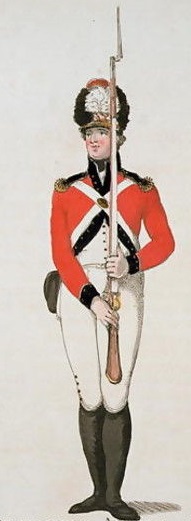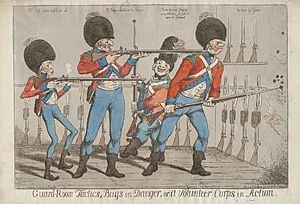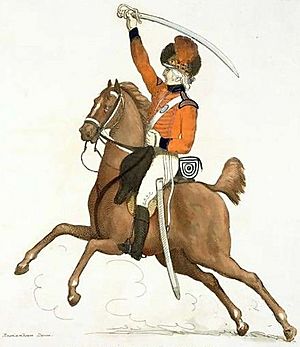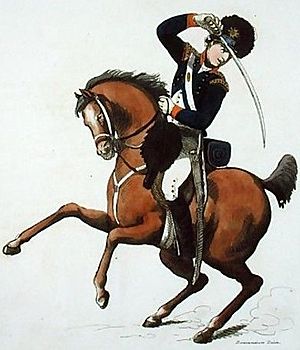British Volunteer Corps facts for kids

The Volunteer Corps was a special group of part-time soldiers in Britain. They were volunteers, meaning they chose to join. Their main job was to defend Britain if another country tried to invade. This happened during the French Revolutionary and Napoleonic Wars, when Britain was often fighting France.
A Look Back
Getting Started
When the War of the First Coalition began, people living near the coast worried about attacks from France. They wrote to Henry Dundas, who was in charge of war matters. They asked for weapons to protect their homes.
At first, the government said no to forming local defense groups. But some towns like Brighton and Penzance started their own groups anyway. Soon, Mr. Dundas and another leader, Lord Amherst, made a plan for volunteer forces. King George III approved it in February 1794.
On March 14, 1794, the plan was sent out. Local leaders called lords lieutenant helped set up these new forces. They also collected money from rich people to support the volunteers. The government, led by William Pitt the Younger, passed a law called the Volunteer Act 1794 to make it official.
The Volunteer Corps had three main jobs:
- To guard coastal artillery batteries (big guns near the sea).
- To help the regular Militia (another home defense force) as infantry (foot soldiers).
- To form cavalry (soldiers on horseback), which were called Yeomanry.
Later, the government worried there weren't enough cavalry volunteers. So, they passed the Provisional Cavalry Act 1796. This law tried to get more horsemen by asking people who owned many horses to provide a man for service. However, many counties already had strong Yeomanry groups, so this new act wasn't always needed.
At first, not many people joined. But when France invaded Belgium and some important trials happened in 1794, more people signed up. In 1798, William Pitt asked for even more volunteers. Britain was facing many problems then, like losing battles in Europe and money troubles. More than 300,000 men joined the Volunteer Corps. This huge number helped Britain avoid forcing everyone to join the army, which would have been very unpopular.
Who Joined?
Most members of the Volunteer Corps came from families who owned land or businesses. Officers were usually from wealthy families. The regular soldiers were often from the lower middle class, like shopkeepers or people who ran pubs.
After a failed French invasion of Ireland in 1796 and a small attack at Fishguard, the corps grew even more. Some groups were formed at workplaces, like the 863-man unit at the Cyfarthfa Ironworks in Wales. Here, the workers were the soldiers, and the managers were the officers. These groups, made up of working-class men, became more common as the fear of invasion grew. In one case, a factory owner even told his workers they had to join or lose their jobs!
Sometimes, the Volunteer Corps helped keep peace in Britain. But they weren't always reliable. One group in Wolverhampton refused to stop people rioting over food prices. And some volunteers in Devon actually led riots against farmers in the winter of 1800–01.
The End of the Corps
The foot soldiers of the Volunteer Corps were sent home in 1802 when there was a short peace called the Peace of Amiens. But they were called back in 1803. This was because Napoleon planned to invade Britain, which was a very serious threat.
By the end of 1803, over 340,000 men had joined. This was more than the government had expected! At first, there weren't enough weapons for everyone. Even William Pitt, who was not in power at the time, became a colonel (a high-ranking officer) in a Volunteer Corps unit. The laws that created the Volunteer Corps ended in 1806. Most of the corps were disbanded again in 1813. Only the Yeomanry (the cavalry) stayed active, just in case there were problems inside Britain.
Famous People Who Joined
- Robert Burns, a private soldier in the Royal Dumfries Volunteers.
- David Erskine, a lieutenant colonel in the Bloomsbury and Inns of Court Volunteers.
- William Grant, a captain in the Bloomsbury and Inns of Court Volunteers.
- Edward Austen Knight (who was Jane Austen's brother), a captain in the East Kent Volunteers.
- William Pitt the Younger, a colonel in the Royal Trinity House Volunteer Artillery and the Cinque Ports Volunteer Corps.
- Walter Scott, a Quartermaster and Secretary in the Royal Edinburgh Volunteer Light Dragoons.
- Richard Brinsley Sheridan, a lieutenant colonel in the St James's Volunteer Corps.





